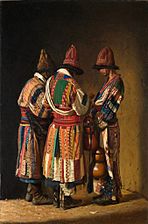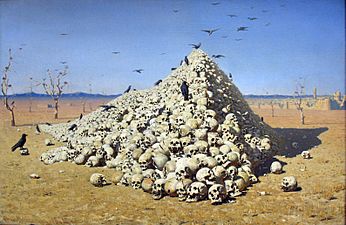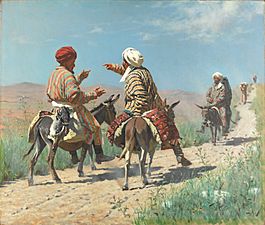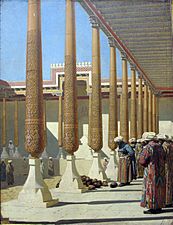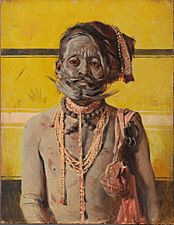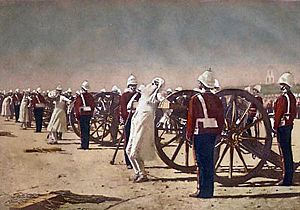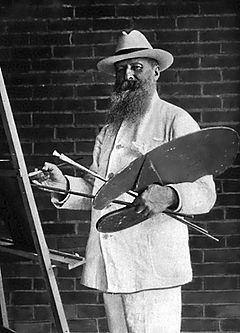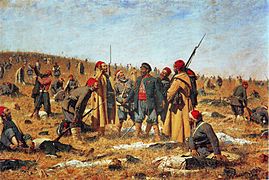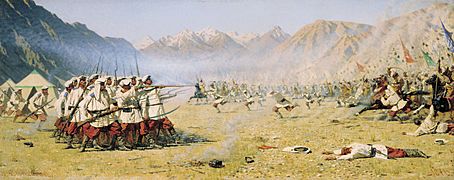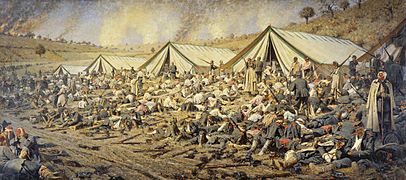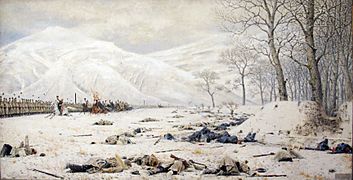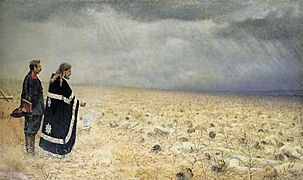Vasily Vereshchagin facts for kids
Quick facts for kids
Vasily Vereshchagin
|
|
|---|---|
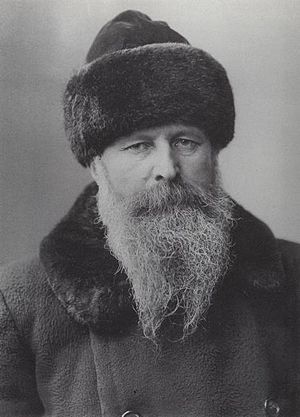
Vasily Vereshchagin
|
|
| Born | October 26, 1842 Cherepovets, Novgorod Governorate, Russia
|
| Died | April 13, 1904 (aged 61) Port Arthur, Russia
(now China) |
| Nationality | Russian |
| Education | Professor by rank (1874) |
|
Notable work
|
St Petersburg Academy |
| Awards | Order of St. George (4th class) |
Vasily Vasilyevich Vereshchagin (Russian: Васи́лий Васи́льевич Вереща́гин; October 26, 1842 – April 13, 1904) was a very famous Russian artist. He was known as a war artist, meaning he painted scenes from wars. He was one of the first Russian artists to be recognized around the world. His paintings were very realistic and showed the harsh truth of war. Because of this, some of his works were not shown in public for a long time.
Contents
Becoming an Artist: Vasily's Early Life
Vasily Vereshchagin was born in 1842 in Cherepovets, Novgorod Governorate, Russia. He was the middle of three brothers. His father was a landowner, and his mother had Tatar family roots.
When Vasily was eight, he went to a special school called the Alexander Cadet Corps. Three years later, he joined the Sea Cadet Corps in St Petersburg. This was a school for future naval officers. In 1858, he went on his first sea trip. He sailed on a ship called the Kamchatka to countries like Denmark, France, and Egypt.
Vasily was a top student at the naval school. But after graduating, he decided to leave the navy. He wanted to focus on studying art. In 1863, he won a medal from the St Petersburg Academy for his painting Ulysses Slaying the Suitors. The next year, he went to Paris to study art further. He learned from a famous artist named Jean-Léon Gérôme.
Adventures in Central Asia: Painting New Worlds
In 1866, Vereshchagin showed a drawing at the Paris Salon. It was called Dukhobors chanting their Psalms. The next year, he was invited to join a trip to Turkestan with General Konstantin Petrovich Kaufman. He was given a special rank for this journey.
Vasily showed great bravery during the Siege of Samarkand (1868) in June 1868. For his courage, he received the Cross of St George medal. He loved to travel and explore. He returned to St Petersburg in late 1868, then went to Paris in 1869. Later that year, he was back in St Petersburg. By the end of 1869, he traveled back to Turkestan through Siberia.
In 1871, Vereshchagin set up his art studio in Munich. He held his own art show in London in 1873. This show featured his paintings from his travels, known as his "Turkestan Series". He had another exhibition in St Petersburg in 1874. However, two of his paintings were not allowed to be shown. These were The Apotheosis of War and Left Behind. They were considered too harsh because they showed the Russian military in a difficult light.
In late 1874, Vereshchagin began a long journey. He explored the Himalayas, India, and Tibet. He spent more than two years traveling before returning to Paris in late 1876.
Vasily's Role in the Russo-Turkish War
When the Russo-Turkish War (1877–1878) began, Vereshchagin left Paris. He rejoined the Imperial Russian Army. He was present at important battles, like the crossing of the Shipka Pass and the Siege of Plevna. Sadly, his brother was killed during this war. Vasily himself was badly wounded while preparing to cross the Danube River. After the war ended, he worked as a secretary for General Skobelev.
Gaining World Fame: Art and Controversy
After the war, Vereshchagin settled in Munich. He quickly painted many war pictures. These paintings showed the terrible side of war. His goal was to promote peace by showing how awful war truly is. This message attracted many people who usually weren't interested in art. He held successful exhibitions in Paris in 1881, and then in London, Berlin, Dresden, Vienna, and other cities.
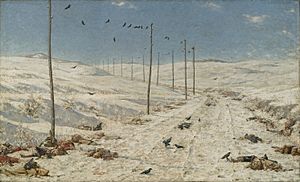
Vereshchagin also painted scenes of British India. His huge painting, The State Procession of the Prince of Wales into Jaipur in 1876, is one of the largest paintings in the world. He traveled to India again in 1882–1883.
Some of his paintings caused a lot of discussion. One series included a Roman execution, Suppression of the Indian Revolt by the English, and an execution in St Petersburg. His painting Suppression of the Indian Revolt by the English showed sepoys being executed by being tied to the barrels of guns. Some people argued that this method was only used in the Indian Rebellion of 1857. However, Vereshchagin's painting showed modern soldiers, making it seem like the practice was still happening. In 1887, Vereshchagin explained that he believed the British would use this method again if there was another rebellion.
By the late 1800s, Vereshchagin was very popular in Russia and abroad. His name was often in newspapers in Europe and America. Unlike other artists who made war look like a parade, Vereshchagin showed the true horrors. He once wrote, "I loved the sun all my life, and wanted to paint sunshine. When I happened to see warfare and say what I thought about it, I rejoiced that I would be able to devote myself to the sun once again. But the fury of war continued to pursue me."
In 1882, German field marshal Helmuth von Moltke the Elder visited Vereshchagin's exhibition in Berlin. Vereshchagin showed Moltke his painting The Apotheosis of War. The painting seemed to confuse the field marshal. After his visit, Moltke ordered German soldiers not to visit the exhibition. The Austrian war minister did the same.
In Russia, Vereshchagin's art was also sometimes banned from exhibitions. People accused him of making the Russian army look bad. Vasily was very upset by these unfair accusations. He even burned three of his own paintings: The Forgotten Soldier, They Have Encircled, and Pursue and They Entered.
In 1884, he traveled to Syria and Palestine. This trip gave him ideas for paintings about the New Testament. These paintings also caused discussion because they showed Jesus in a very realistic way. Some people thought his portrayal was too ordinary or too focused on his Semitic background.
His "1812" series of paintings was about Napoleon's Russian campaign. Vereshchagin also wrote a book about it. These paintings were inspired by Tolstoi's famous book War and Peace. He painted them in 1893 in Moscow, where he eventually made his home.
Vasily's Final Years and Legacy
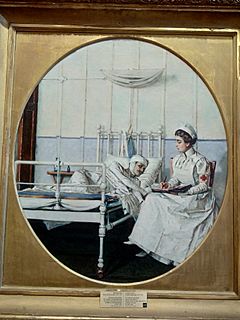
Vereshchagin continued his travels in his later years. He was in the Far East during the First Sino-Japanese War (1894–1895). He was also with Russian troops in Manchuria during the Boxer Rebellion in 1900. In 1901, he visited the Philippines. In 1902, he went to the United States and Cuba. In 1903, he visited Japan.
During the Russo-Japanese War, Admiral Stepan Makarov invited Vereshchagin to join him on his battleship, the Petropavlovsk. On April 13, 1904, the Petropavlovsk hit two underwater mines. The ship sank while returning to Port Arthur. Most of the crew, including Admiral Makarov and Vasily Vereshchagin, died. Vereshchagin's very last painting, which showed a war meeting led by Admiral Makarov, was found almost undamaged.
What is Vasily Vereshchagin Remembered For?
- The town of Vereshchagino in Perm Krai is named after him.
- A minor planet, 3410 Vereshchagin, was discovered in 1978 and named in his honor.
- There is a street, a historic house museum, and a monument dedicated to Vereshchagin in his hometown of Cherepovets.
- His famous painting The Apotheosis of War was used as album cover art by the Czech heavy metal band Arakain.
Gallery
See also
 In Spanish: Vasili Vereshchaguin para niños
In Spanish: Vasili Vereshchaguin para niños
- List of Orientalist artists
- Orientalism


